An Art Heist of Cabbages
I love a good art heist—a book or a movie. And if I could have one unlimited vice to pander to, it would be to collect all the paintings I love in my own private museum. As it is, Camont’s walls are filling up nicely with small and unpretentious paintings, some old and found at local brocantes, others from local artist friends; my favorites are on small panels of wood, often mahogany, and reflect the late 1800s to early 1900s style—still lifes, landscapes, boats, interiors, and gardens. So, I began looking for paintings with cabbages that I could steal, as it seemed to be the theme of my November food, and I found Pissarro.
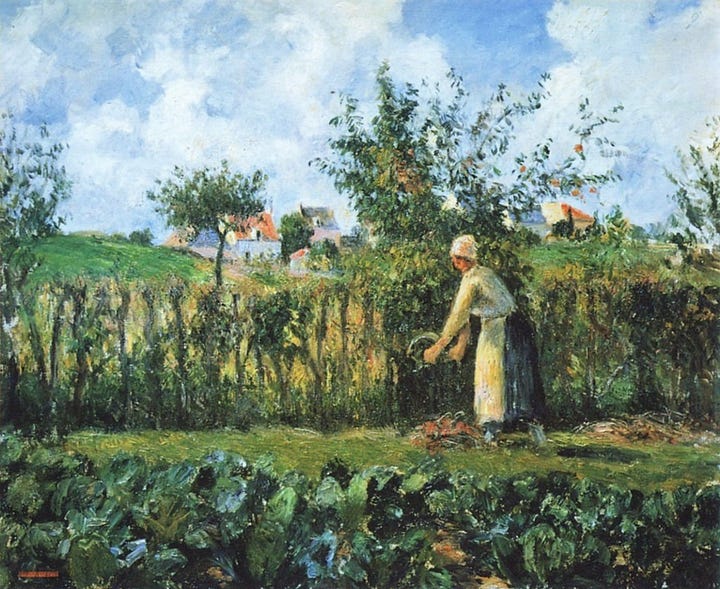
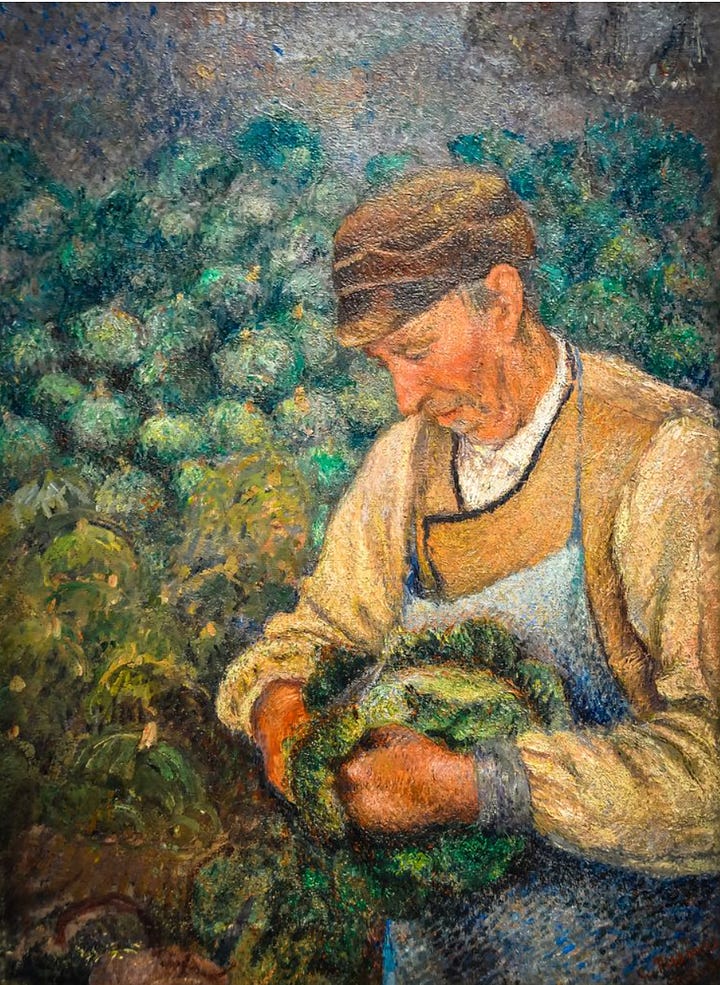
I love these gentle paintings by the French artist Camille Pissarro1. Did you know he was born in St. Thomas in the Virgin Islands and came to la Belle France first as a young student and before returning as a young man intent on studying painting? The gentle sunlit palette of his early Caribbean paintings seems to underpin his later French impressionist paintings—like a peasant girl wearing a colorful silk slip beneath a heavier woolen skirt. He would tell Cezanne, whom he mentored, to “Lighten your palette.” He was often called the first Impressionist.
If I owned these paintings, I would hang these two in my kitchen gallery as everyday inspiration to grow and cook what looks so beautiful in the garden. Instead, they are in the Martelli Collection in Florence, Italy, and the National Gallery of Art, Washington, D.C., USA, probably not on view.
Les Choux in the Garden and on the TV
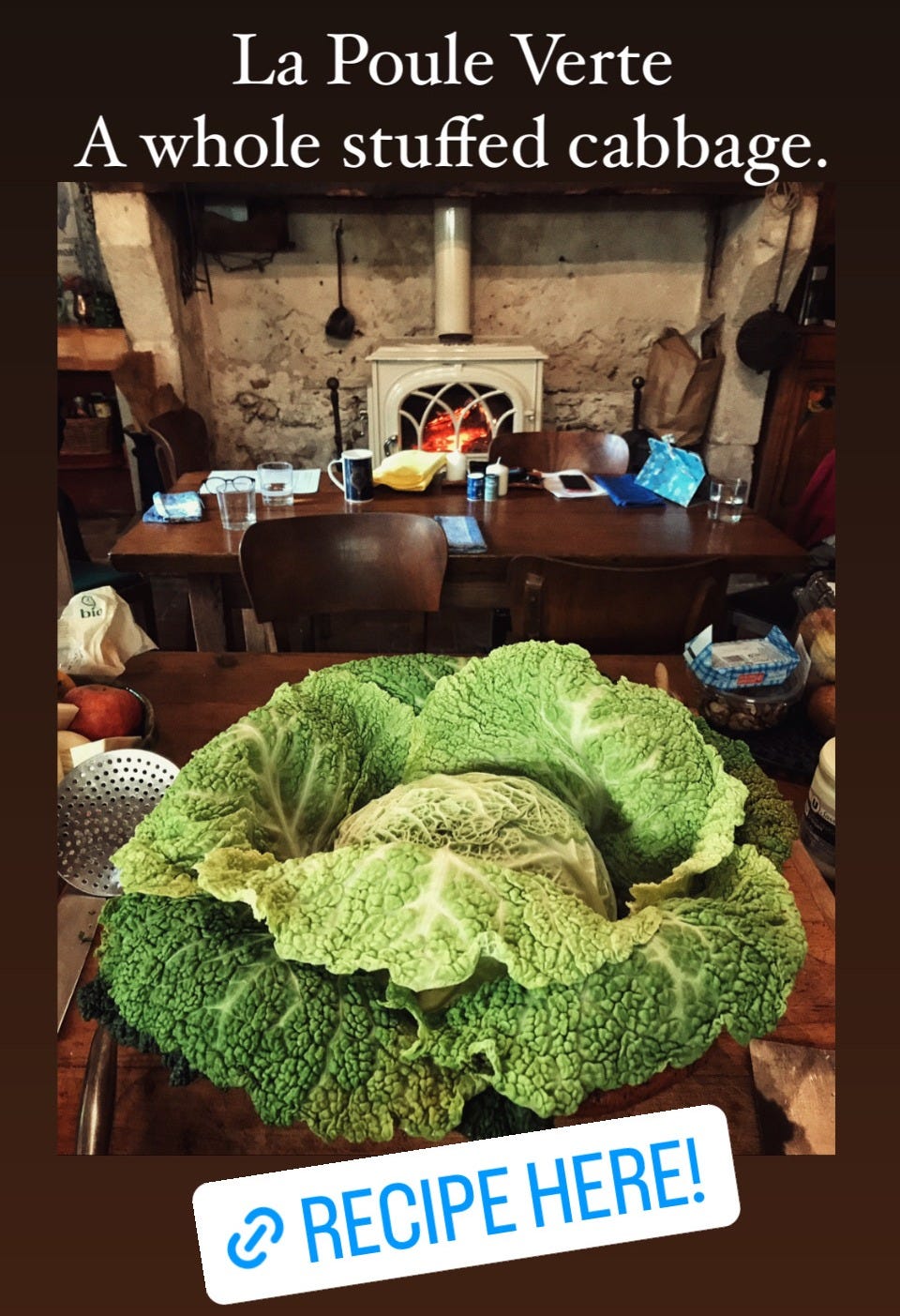
It's time for truth in advertising. My own garden is pretty scruffy this year, but there are still hardy, deep green chard leaves to harvest, onions sprouting for the scallion green stems, and all the fresh herbs for seasoning the soups and braises I pivot toward this month—sage, chives, thyme, parsley—yet nary a cabbage in sight. However, a giant Savoy cabbage was the star of my kitchen this week as I dedicated a long day working with a film crew from France 3 TV-Nouvelle Aquitaine to make a giant stuffed cabbage. And how does that even happen?
A couple of weeks ago, Mathilde B., producer and journalist for the French television program “Le Goût des Rencontres—Nouvelle-Aquitaine2” ( A Taste for Meeting People in the Nouvelle Aquitaine region), contacted me because she saw my recipes and photos for a Poule Verte or Chou Farçi (stuffed cabbage) on my Instagram account (see link in the caption above).
This regional program explores hyper-local producers and cooks who make contemporary connections from field to table for a young French audience. Valentine Sled, the new host, presenter, and a well-known Instagram figure in Paris, would watch and help me make my version of the classic recipe at Camont. As it turns out, she was also one of the judges for the recent French national Chou Farçi competition in Paris, but had never come across La Poule Verte, or Green Chicken or whole stuffed cabbage, that I wrote about last week here. The local distinction for food names seems to extend beyond the Chocolatine vs. Pain au Chocolate battle and my new Parisian friends thought I was making it up.
Since we were filming on a Monday, I shopped over the weekend and bought three beautiful frilly Savoy cabbages from Ferme Bisetto down the road (Three! You never know; be prepared!). I made cornbread for the stuffing on Sunday (my American touch!); I prepped all the ingredients and tools needed at hand. The nicest old torchons (tea towels) were washed, folded, and stacked, a few farm eggs were gathered for their deep orange yolks, and I wrote the menu on my blackboard like usual.
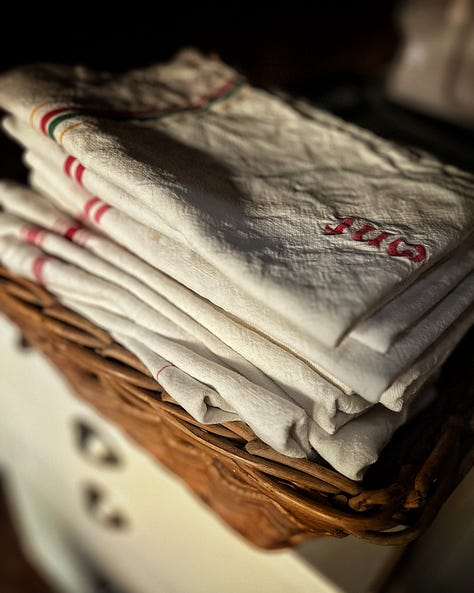
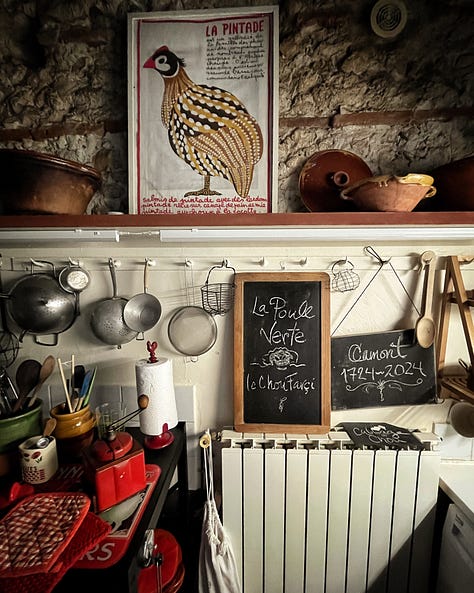
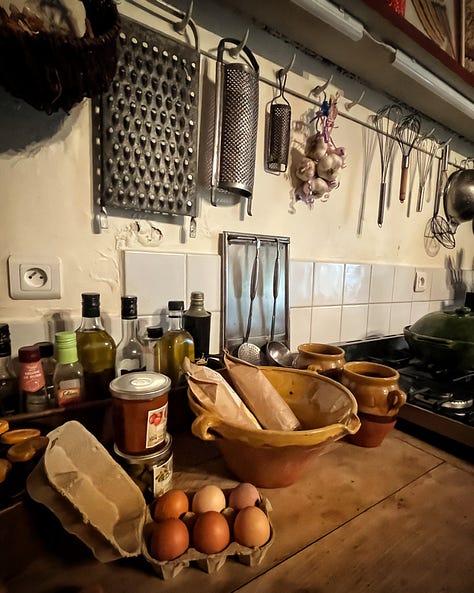
The crew of six arrived Monday morning with the first diffused light; it took most of the morning to light my cave-dark kitchen with battery-powered lights in every corner and giant bright umbrella reflectors connected by a maze of cables. All the rest of the day, Valentine and I set up, stopped, waited, and then began cooking whenever the director called “moteur” (or “action” in English). While none of this was new to me or my kitchen, as I have been filmed (and filmed myself) hundreds of times in this small space, I wanted to say…
“Ce n'est pas mon premier rodéo.”
But I had a niggle in the back of my mind keeping me distracted from the cheap thrills of the production. The producer wanted my backstory: how did I get to France? (On a canal barge, of course.) What made me stay here in this little-known area? (Remember they are young Parisians, and to them, this is the beyond the back of beyond.) How did I learn to cook? (Doesn’t everyone have an Italian Grandmother and grew up in the kitchens of a few restaurants?) And all the other expected clichéd questions about being an American expat in France.
Of course, I have spent the last year here on Substack writing my memoir “Finding France”3 and telling exactly these same stories. However, I struggled with speaking in French this time, distracted by being corrected for using the vouvoyez, a more formal verb form, instead of the tutoyer or a more familiar approach to addressing contemporaries. (Full disclosure: My French is far from perfect, but I have never had a problem making myself clear before—except for national television. At 73, I am not as bothered as they were.)
The young film crew were wonderfully serious, with four cameras, a GoPro, a buzzing drone, and a sun-bright array of lights stuck in every kitchen corner. All the angles were covered. I am sure the cabbage will look beautiful; my wrinkles, not so much. But my kitchen looks like a movie set; I designed it that way. And the shabby garden that is a bit passé? In early November, the golden light reflecting off falling leaves showed the promise of more colors other than green and sparkled prettily in the late afternoon sun. I vowed to extend my colorful potager season a bit more next year by planting towering Brussels sprouts, dark green kale, and more orange squash, gourds, and flowers.
The Poule Verte turned out well for all the holding and reheating. Valentine invited me to enter the national competition next year in Paris. I would have to bring my own cabbage from here, of course. But if I can make one small advance to preserving a classic Gascon recipe, it will be worth it. This France 3 TV program will air sometime in January, and I’ll post a link to the website when it does.
In the meantime, you can stuff your own “green chicken” by accessing the recipes in the previous post now open to all free subscribers: https://katehillfrance.substack.com/p/camonts-kitchen-stairs-library-paula
Reminder: while this link is now open for all free subscribers, most recipes are archived for paid subscribers. This is how food writers, recipe developers, cooks, and storytellers can afford to stay self-employed. I so appreciate your support and thank you for subscribing and contributing when possible.
A Taste of Possibility
What else does this golden month hold in store? I’ve deliberately planned it to be quiet, with no residents or guests in the Relais, as a pause between seasons like an “em dash” after a long run-on sentence of a year. I am planning ahead as always, as I believe there are no accidents in all the serendipitous energy of a long life. I like to be prepared for adventure.
It is time to infuse new efforts into spreading the word about The Relais de Camont as a more intimate alternative to the chateau-style writers’ residencies. With just three residents at a time year-round, serious, hard-working, and disciplined writers and artists leave their egos at the door to let their work speak for themselves. Please help spread the word by sharing these free newsletters and the website.
And yes, November will have a French Thanksgiving of some form, a small birthday celebration for this Sagittarius, and some decorating and rearranging in my wing of the barn. More space for hanging paintings? I’ll share some of my favorite November recipes and stories of life in the rural byways of Southwest France. There is Armagnac to be distilled and duck confit is to be made. November is the month to fill the pantry for the holidays. Thanks for joining me this month to explore the tastier side of Champêtre.
Up Next this month:
— A RoadTrip through Gasconia! a long-promised drive around the Armagnac country
—Memories of Gascony by Pierre Koffmann is another foundation book from my Kitchen Stairs Library
—French Vintage Treasures- Meet Maiden France, a prop stylist’s dream resource!




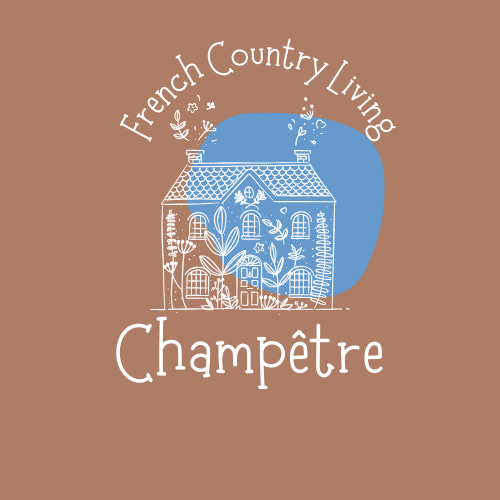
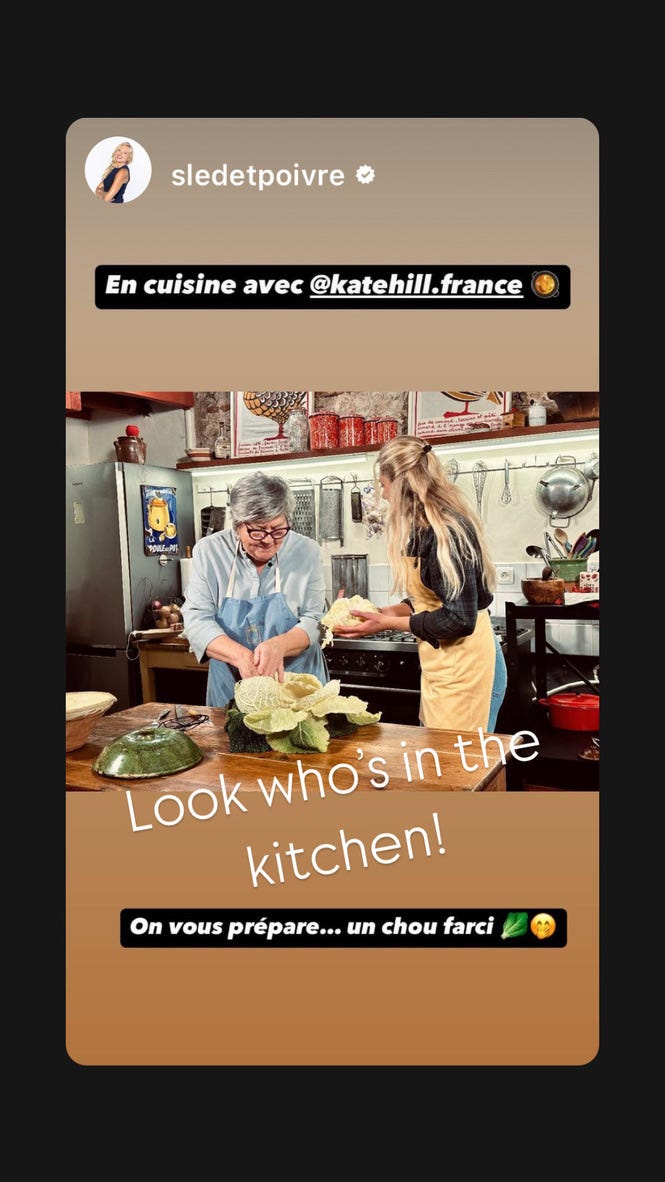
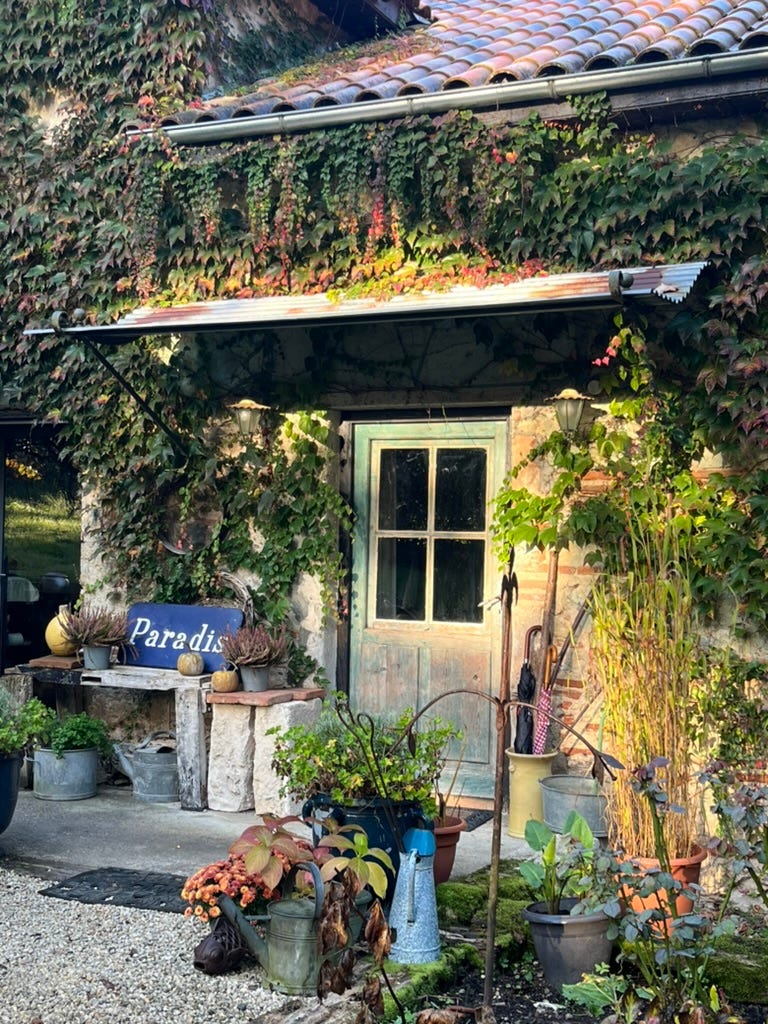
Lovely story - Look forward to your e-mails each month. Thank you Kate!
I searched "vintage cabbage paintings" on Etsy and there are some gorgeous (well priced) watercolors and oil paintings there if you don't go the museum heist route.... Love your posts!